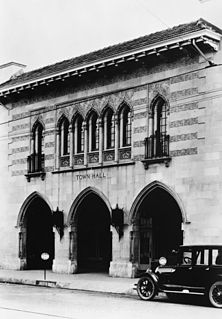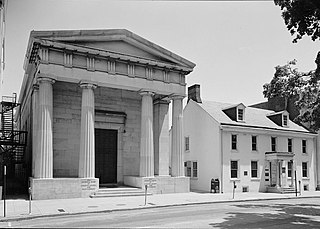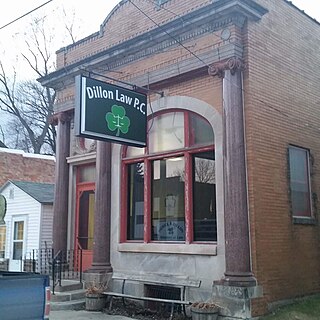
The Henry Adams Building, also known as the Land and Loan Office Building, is a historic building located in Algona, Iowa, United States. It was designed by Louis Sullivan in 1912.

The Merchants' National Bank (1914) building is a historic commercial building located in Grinnell, Iowa. It is one of a series of small banks designed by Louis Sullivan in the Midwest between 1909 and 1919. All of the banks are built of brick and for this structure he employed various shades of brick, ranging in color from blue-black to golden brown, giving it an overall reddish brown appearance. It was declared a National Historic Landmark in 1976 for its architecture. In 1991 it was listed as a contributing property in the Grinnell Historic Commercial District.

The Van Allen Building, also known as Van Allen and Company Department Store, is a historic commercial building at Fifth Avenue and South Second Street in Clinton, Iowa. The four-story building was designed by Louis Sullivan and commissioned by John Delbert Van Allen. Constructed 1912–1914 as a department store, it now has upper floor apartments with ground floor commercial space. The exterior has brick spandrels and piers over the structural steel skeletal frame. Terra cotta is used for horizontal accent banding and for three slender, vertical applied mullion medallions on the front facade running through three stories, from ornate corbels at the second-floor level to huge outbursts of vivid green terra cotta foliage in the attic. There is a very slight cornice. Black marble facing is used around the glass show windows on the first floor. The walls are made of long thin bricks in a burnt gray color with a tinge of purple. Above the ground floor all the windows are framed by a light gray terra cotta. The tile panels in Dutch blue and white pay tribute to Mr. Van Allen's Dutch heritage of which he was quite proud.. The Van Allen Building was declared a National Historic Landmark in 1976 for its architecture.

The People's Federal Savings and Loan Association is a historic bank building at 101 East Court Street in Sidney, Ohio, designed by Chicago architect Louis Sullivan. It was designed and built in 1917 for use by Peoples Federal Savings and Loan Association, which still operates out of it. It is one of a handful of banks designed by Sullivan between 1908 and 1919 for small communities in the central United States. The building is a National Historic Landmark.

Jules Jacques Benois Benedict was one of the most prominent architects in Colorado history, whose works include a number of well-known landmarks and buildings listed on the National Register of Historic Places.

The Samuel Kraemer Building, in Anaheim, California, was built in 1924-1925 by Samuel Kraemer.

The National State Bank Building is located on River Street in Troy, New York, United States, at its junction with Fulton and Third streets. It was listed on the National Register of Historic Places in 1970, one of the earliest buildings in the city so recognized. Since 1986 it has been a contributing property to the Central Troy Historic District.

There are 70 properties listed on the National Register of Historic Places in Albany, New York, United States. Six are additionally designated as National Historic Landmarks (NHLs), the most of any city in the state after New York City. Another 14 are historic districts, for which 20 of the listings are also contributing properties. Two properties, both buildings, that had been listed in the past but have since been demolished have been delisted; one building that is also no longer extant remains listed.
Tourtellotte & Hummel was an American architectural firm from Boise, Idaho and Portland, Oregon.
John Augustus Dempwolf was a York, Pennsylvania-based architect. He was born in Germany as the eldest of 12 brothers and sisters. Dempwolf immigrated to the United States at 19, and settled at York. He studied architecture at the Cooper Union in New York. He then worked in Boston, where he supervised construction of the Holy Cross Cathedral. He worked as an architect at Philadelphia with architect Steven Button and helped him design buildings for the Centennial Exposition. He started his own practice in 1876 at York, and was joined by his brother Reinhardt and later his son Frederick. The practice designed over 600 buildings through 1920.

Bank of Chester County is a historic two-story bank building located in West Chester, Chester County, Pennsylvania, the first bank to be chartered in the county. Following the failure to renew the charter of the Bank of the United States in 1811, states received responsibility over the banking systems within their jurisdiction. Although an initial proposal was rejected by the state legislature in 1813, a 41-bank proposal was passed the following year. An early bank building was utilized in West Chester beginning in 1814 at the Record Office, though the bank was relocated in 1818 to a building across the street, present-day 13 High Street. Following a proposal for a new site in 1835, a bank, to be built at 17 High Street, designed by architect Thomas Ustick Walter (1804–1887). It was built in 1836 in the Greek Revival style at the cost of $33,000, and features a portico with four Doric order columns; the bank was subsequently altered in 1874, 1905, and 1928. The previous building has since been rented to numerous individuals, although it still houses outdated equipment no longer used by the bank. The current building is occupied by Wells Fargo.

The Ayers Bank Building is a historic bank building located at 200 West State Street in Jacksonville, Illinois. This site is believed to have been continuously associated with banking since 1832, longer than any other site in Illinois.

Farmers and Merchants Savings Bank, also known as Union Savings Bank and First Trust and Savings Bank, is an historic building located in Grand Mound, Iowa, United States. It was listed on the National Register of Historic Places in 2001.

The State Bank of Stratford is a historic building located in Stratford, Iowa, United States. The bank opened for business in 1891, eight years after the town was incorporated. Its early success reflected the prosperity in rural Iowa at the time. The bank occupied this corner since 1910, and this building was completed in 1918. The older building was relocated to the west, and it is still extant. It survived the agricultural economic downturn of the 1920s, but it could not survive the Great Depression. The bank building was purchased in 1936 by the Farmer's Savings Bank, which operated in this building until a new bank building was built across the street to the south. The Georgian Revival elements of the building include the pedimented entrance portico, elliptical arched windows, the brick quoining on the corners, and the dentilated cornice. The building was listed on the National Register of Historic Places in 1983.
Merrill H. Hoyt was a prominent American architect, business man and leader in the building design community of Denver, Colorado from 1910 to 1933.

Ivey P. Crutchfield (1878-1952) was an American architect and builder who worked in Georgia and Florida. Several of his works are listed on the National Register of Historic Places for their architecture.

Farmers' State Bank is a historic building located in Volga, Iowa, United States. Its significance is derived from its Beaux-Arts architecture and the bank's role in the town's early 20th-century agriculture-based economy and railroad development along a branch of the Chicago, Milwaukee & St. Paul Railroad. Completed in 1912, the Beaux Arts elements on the buildings main façade includes a large elliptical-arch window, Ionic granite columns, classical entablature, and circle window above the door framed by garlands. Farmers' State Bank was Volga's second financial institution. It survived the downturn in the farm economy in the 1920s before it merged with the other bank in town in 1931 to form Iowa State Savings Bank. That bank used this building until the following year when it failed. The city of Volga acquired the building in 1935 and used it for its public library and city hall. It was used for a bank again from 1947 to 2015 when it housed Volga State Bank and the Volga branch of Central State Bank of Elkader. The building then housed a law office. It was listed on the National Register of Historic Places in 2018.

Abraham Horace Albertson was an American architect who was one of Seattle, Washington's most prominent architects of the first half of the 20th century. He was born in New Jersey and educated at Columbia University in New York. Early in his career, he moved to Seattle in the employ of a well-known New York architectural firm with that was developing a large area in downtown. He worked on many projects in Seattle from around 1910 through the 20s and early 30s. Some of his designs are Seattle landmarks and/or listed on the National Register of Historic Places.

















